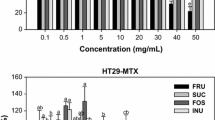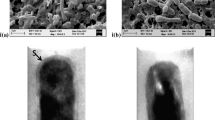Abstract
Cronobacter sakazakii is an opportunistic pathogen that has been implicated in meningitis, NEC, and sepsis in neonates. Colonization and subsequent infection and invasion of C. sakazakii require that the organism adheres to host cell surfaces. Agents that inhibit or block attachment of the pathogen to epithelial cells could be useful in reducing infections. The goal of this research was to assess the ability of prebiotic galactooligosaccharides (GOS) and polydextrose (PDX) to inhibit adherence of C. sakazakii 4603 to a HEp-2 human cell line. Adherence experiments were performed in the presence or absence of prebiotics using HEp-2 cells grown to confluency on glass coverslips. Prebiotics and bacteria were added and incubated for 3 h. Coverslips were washed, and adherence was determined by cultural and microscopic methods. When measured microscopically or by cultural methods, significant reductions in adherence (56 and 71%, respectively) of C. sakazakii were observed in the presence of GOS (16 mg/ml). Adherence inhibition also occurred (48%) when a GOS–PDX blend (8 mg/ml each) was tested, although PDX by itself had less effect. Similar results were also observed for Caco-2 cells and also for another strain of C. sakazakii (29004). These results suggest that GOS and PDX, alone and in combination, may have an anti-adhesive effect on C. sakazakii and directly inhibit the adherence to gastrointestinal epithelial cells.




Similar content being viewed by others
References
Gibson GR, Roberfroid M (1995) Dietary modulation of human colonic microbiota-introducing concept the concept of prebiotics. J Nutr 125:1401–1412
Gibson GR, McCartney AL, Rastall RA (2005) Prebiotics and resistance to gastrointestinal infections. Br J Nutr 93(Suppl 1):S31–S34
Saulnier DMA, Spinler JK, Gibson GR et al (2009) Mechanisms of probiosis and prebiosis: considerations for enhanced functional foods. Curr Opinion Biotechnol 20:135–141
Shoaf-Sweeney K, Hutkins RW (2009) Adherence, anti-adherence, and oligosaccharides: preventing pathogens from sticking to the host. Adv Food Nutr Res 55:101–161
Boddicker JD, Ledeboer NA, Jagnow J et al (2002) Differential binding to and biofilm formation on, HEp-2 cells by Salmonella enterica serovar Typhimurium is dependent upon allelic variation in the fimH gene of the fim gene cluster. Mol Microbiol 45:1255–1265
Cleary J, Lai L-C, Shaw RK et al (2004) Enteropathogenic Escherichia coli (EPEC) adhesion to intestinal epithelial cells: role of bundle-forming pili (BFP), EspA filaments and intimin. Microbiology 150:527–538
Isaacson RE (1983) Bacterial adherence to mucosal surfaces: an attribute of virulence. Bull Eur Physiopath Respir 19:75–80
Sharon N, Ofek I (2002) Fighting infectious diseases with inhibitors of microbial adhesion to host tissues. Crit Rev Food Sci Nutr 42:267–272
Zorf D, Roth S (1996) Oligosaccharides anti-infection agents. Lancet 347:1017–1021
Searle LEJ, Best A, Nunez A et al (2009) A mixture containing galactooligosaccharide, produced by the enzymic activity of Bifidobacterium bifidum, reduces Salmonella enterica serovar Typhimurium infection in mice. J Med Microbiol 58:37–48
Kunz C, Rudloff S, Baier W et al (2000) Oligosaccharides in human milk: structural, functional, and metabolic aspects. Ann Rev Nutr 20:699–722
Sharon N, Ofek I (2000) Safe as mother’s milk: carbohydrates as future anti-adhesion drugs for bacterial diseases. Glycoconj J 17:659–664
Shoaf K, Mulvey GL, Armstrong GD et al (2006) Prebiotic galactooligosaccharides reduce adherence of enteropathogenic Eschericchia coli to tissue culture cells. Infect Immun 74:6920–6928
Sinclair HR, de Slegte J, Gibson GR et al (2009) Galactooligosaccharides (GOS) inhibit Vibrio cholerae toxin binding to its GM1 receptor. J Agri Food Chem 57:3113–3119
Oliveira RPS, Florence ACR, Silva RC et al (2009) Effect of different prebiotics on the fermentation kinetics, probiotic survival and fatty acids profiles in nonfat symbiotic fermented milk International. J Food Microbiol 128:467–472
Probert HM, Apajalahti JH, Rautonen N et al (2004) Polydextrose, lactitol, and fructo-oligosaccharide fermentation by colonic bacteria in a three-stage continuous culture system. Appl Environ Microbiol 70:4505–4511
Bowen AB, Braden CR (2006) Invasive Enterobacter sakazakii disease in infants. Emerg Infect Dis 12:1185–1189
Iversen C, Mullane N, McCardell B et al (2007) Cronobacter gen. nov., a new genus to accommodate the biogroups of Enterobacter sakazakii, and proposal of Cronobacter sakazakii gen. nov., comb. nov., Cronobacter malonaticus sp. nov., Cronobacter turicensis sp. nov., Cronobacter muytjensii sp. nov., Cronobacter dublinensis sp. nov., Cronobacter genomospecies 1, and of three subspecies, Cronobacter dublinensis subsp. dublinensis subsp. nov., Cronobacter dublinensis subsp. lausannensis subsp. nov. and Cronobacter dublinensis subsp. lactaridi subsp. nov. Int J Syst Evol Microbiol 58:1442–1447
Petrosyan M, Guner YS, Williams M et al (2009) Current concepts regarding the pathogenesis of necrotizing enterocolitis Pediatr Sur Int 25:309–318
Lai KK (2001) Enterobacter sakazakii infections among neonates, infants, children, and adults: case reports and a review of the literature. Medicine (Baltimore) 80:113–122
Gurtler JB, Kornacki JL, Beuchat LR (2005) Enterobacter sakazakii: a coliform of increased concern to infant health. Int J Food Microbiol 104:1–34
Hammerman C, Kaplan M (2006) Probiotics and neonatal intestinal infection. Curr Opinion Infect Dis 19:277–282
Flood MT, Auerbach MH, Craig SAS (2004) A review of the clinical toleration studies of polydextrose in food. Food Chem Toxicol 42:1531–1542
Mange JP, Stephan R, Borel N et al (2006) Adhesive properties of Enterobacter sakazakii to human epithelial and brain microvascular endothelial cells. BMC Microbiol 6:58–62
Friedemann M (2007) Enterobacter sakazakii in food and beverages (other than infant formula and milk powder). Int J Food Microbiol 116:1–10
Iversen C, Forsythe S (2004) Isolation of Enterobacter sakazakii and other Enterobacteriaceae from powdered infant formula and related products. Food Microbiol 21:771–776
Coppa GV, Zampini L, Galeazzi T et al (2006) Human milk oligosaccharides inhibit the adhesion to Caco-2 cells of diarrheal pathogens: Escherichia coli, Vibrio cholerae, and Salmonella fyris. Pediatr Res 59:377–382
Martín-Sosa S, Martín MJ, Hueso P (2002) The sialylated fraction of milk oligosaccharides is partially responsible for binding to enterotoxigenic and uropathogenic Escherichia coli human strains. J Nutr 132:3067–3072
Mohan Nair MK, Venkitanarayanan KS (2007) Role of Bacterial OmpA and host cytoskeleton in the invasion of human intestinal epithelial cells by Enterobacter sakazakii. Pediatr Res 62:664–669
Hernot DC, Boileau TW, Bauer LL et al (2009) In vitro fermentation profiles, gas production rates, and microbiota modulation as affected by certain fructans, galactooligosaccharides, and polydextrose. J Agric Food Chem 57:1354–1361
Vester Boler BM, Hernot DC, Boileau TW et al (2009) Carbohydrates blended with polydextrose lower gas production and short-chain fatty acid production in an in vitro system. Nutr Res 29:631–639
Jie Z, Bang-Yao L, Ming-Jie X et al (2000) Studies on the effects of polydextrose intake on physiologic functions in Chinese people. Am J Clin Nutr 72:1503–1509
Ziegler E, Vanderhoof JA, Petschow B et al (2007) Term infants fed formula supplemented with selected blends of prebiotics grow normally and have soft stools similar to those reported for breast-fed infants. J Ped Gastro Nutr 44:359–364
Boehm G, Stahl B (2007) Oligosaccharides from milk. J Nutr 137:847S–849S
Fanaro S, Marten B, Bagna R et al (2009) Galacto-oligosaccharides are bifidogenic and safe at weaning: a double-blind randomized multicenter study. J Pediatr Gastr Nutr 48:82–88
Acknowledgments
This study was funded by Mead Johnson Nutrition. The authors are grateful to Dr. K. Venkitanarayanan, Department of Animal Science, University of Connecticut, for kindly providing us with strains of C. sakazakii.
Author information
Authors and Affiliations
Corresponding author
Rights and permissions
About this article
Cite this article
Quintero, M., Maldonado, M., Perez-Munoz, M. et al. Adherence Inhibition of Cronobacter sakazakii to Intestinal Epithelial Cells by Prebiotic Oligosaccharides. Curr Microbiol 62, 1448–1454 (2011). https://doi.org/10.1007/s00284-011-9882-8
Received:
Accepted:
Published:
Issue Date:
DOI: https://doi.org/10.1007/s00284-011-9882-8




